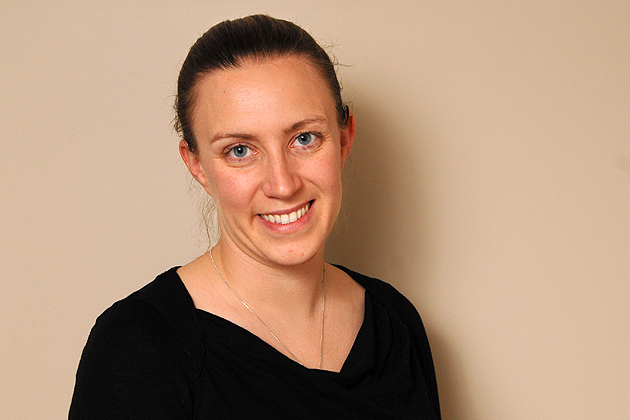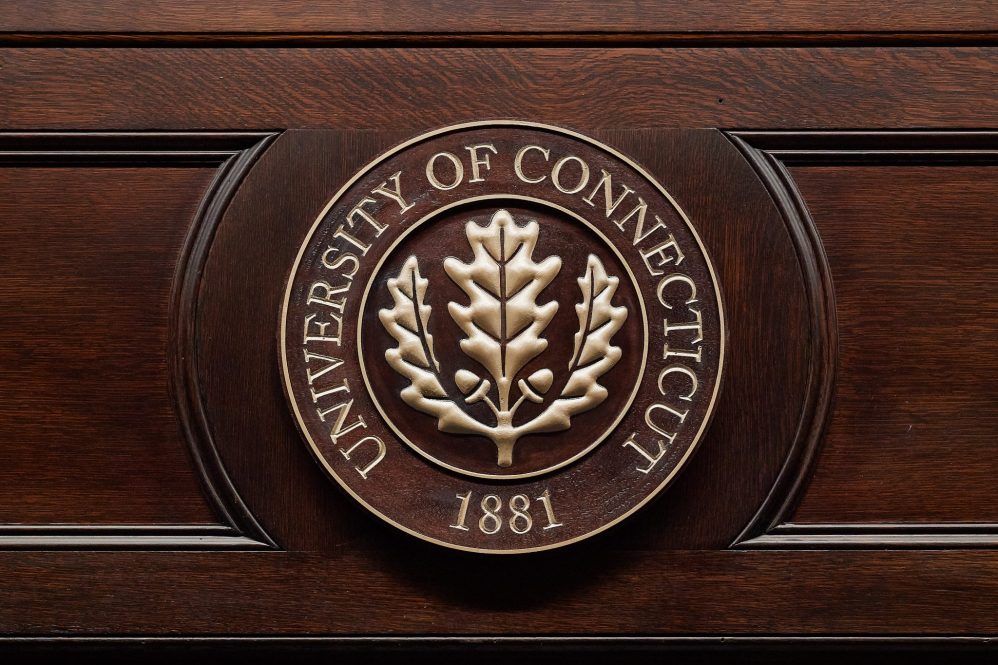As the University counts down to Commencement, UConn Today is featuring some of this year’s outstanding graduating students, nominated by their academic school or college or another University program in which they participated. For additional profiles of students in the Class of 2012, click here.

It’s hard to match UConn Kinesiology Professor Douglas J. Casa’s energy and dedication when it comes to protecting athletes from exertional heat stroke and promoting the research of UConn’s Korey Stringer Institute for the prevention of sudden death in sport.
But the institute’s rise as a major research, advocacy, and educational resource for schools and athletes across the country would not have been possible without the tireless efforts of Rebecca Stearns, a UConn doctoral student who currently serves as the Institute’s vice-president of operations and director of education.
The past year has been a busy one for Stearns, who juggled her dissertation preparations around a hectic travel schedule. Over the past 12 months, Stearns has been flying around the country lobbying for better high school athlete safety protocols in places like Missouri and Florida. The Institute’s goal is to get all 50 states to adopt new guidelines that will phase in intense summer practice sessions for high school athletes, who are particularly prone to exertional heat stroke if they push their bodies too hard too soon in the summer heat.
A certified athletic trainer and researcher with UConn’s Human Performance Lab, Stearns specializes in research dealing with the impact of heat and hydration on sport performance. She has served as the lead author on several journal publications, written book chapters, and co-authored position statements related to preventing sudden death in sport and creating proper safety guidelines for collegiate sport conditioning sessions. For her doctoral thesis, Stearns studied the influence of cold water immersion on muscle recovery and performance in elite athletes participating in the Kona Ironman World Championships.
Last month, Stearns gave a presentation on improving athlete safety before the National Football League’s Players Association in New York City. The Korey Stringer Institute, part of UConn’s Department of Kinesiology in the Neag School of Education, is named after the former NFL player who died of complications from heat stroke following a pre-season training camp in 2001. The NFL is one of the Institute’s sponsors, along with Gatorade and TIMEX.
“Becca has played an integral role in the creation, development, and implementation of the Korey Stringer Institute,” says Casa. “From the start, she has been the in-the-trenches colleague that has allowed the KSI to work toward its goal of preventing sudden death in sport.
“Becca has done more as a doctoral student than most professors do in the first 10 years of their career,” Casa continues. “Keynote talks at major meetings, webinars for national organizations, meetings with executives from Fortune 100 companies, working on policy changes for major sporting organizations … the KSI would not be the KSI without her.”
Stearns’ accomplishments are particularly impressive given the fact that she almost didn’t make it into UConn’s kinesiology graduate program, considered the top doctoral program in the country by the National Academy of Kinesiology.
If Stearns has a weakness, it’s testing. She smiles as she talks about it today. But she admits that when she first enrolled at UConn, she had not passed a section of her athletic trainer certification and almost lost her spot in the program, which required her to serve her graduate assistantship as an athletic trainer at a local high school. But Casa and Professor Carl Maresh, the kinesiology department head, saw Stearns’ potential and rerouted her into a research assistant’s post until she passed the test. The rest, as they say, is history.
“I wouldn’t be where I am today if they had not done that,” says Stearns. “I’m not a test-taker. I attribute my success to just working hard.”
Stearns’ hard work is reflected in the Korey Stringer Institute’s success. Since its founding in April 2010, the institute has become a major research and advocacy center working with states, organizations and athletes around the country.
Always an athlete, Stearns says she also has a passion for science. Her father is a chemist; her mother, a nurse. She became interested in being an athletic trainer after shadowing an athletic trainer for a day at the University of Rochester when she was a high school student in New York. She said athletic training offers a perfect combination of two things she really enjoys.
“I like the excitement that comes from being the first responder on site,” Stearns says. “I also can relate to that passion athletes have for wanting to perform at their best. I really enjoy being the person who can keep people healthy, and essentially aid in that whole process of maximizing an athlete’s performance.”
Stearns says athletic training has come a long way from the stereotyped image of a trainer on the sideline with a towel, a water bottle, and a bag of ice. Today’s athletic trainers use computer diagnostics and remote body sensors to make sure athletes are obtaining peak performance and quick muscle recovery. While they still are often the first ones to treat an athlete’s injury during competition, athletic trainers are also an integral part of athletes’ training preparations, keeping them safe and helping them improve while avoiding injury.
No longer limited to the sidelines, today’s athletic trainers are also in the board room, helping coaches and teams avoid injuries, set policy, and improve performance. Stearns cited recent concerns about concussions in the NFL as one area where athletic trainers have played a key role.
“We’re the ones who are on the field and who work with the athletes every day, so we can help bring these issues to light,” says Stearns. “We know that concussions caused by a traumatic blow can have serious, even fatal, consequences. But as athletic trainers, we’re also bringing to light the damage that can be done by sub-concussive blows, those that may not be immediately measurable but over time can have long-term implications on memory and cause other health deficits.”
Stearns would like to see the same attention given to concussions currently applied to exertional heat stroke in the near future, especially at the high school level.
Unlike the NFL or the NCAA, the National Federation of State High School Associations does not dictate what each state should do in terms of preparing students for interscholastic sports. So it is part of the KSI’s mission to convince each state to adopt new acclimatization guidelines in order to reduce the risk of exertional heat stroke, which can be fatal.
“If you acclimatize athletes prior to the start of intense training and exercise – if you let their bodies adjust to their environment – you can reduce a lot of heat illnesses, injuries, and potential cases of heat stroke,” says Stearns. “That’s one of the biggest things we’re doing to protect athletes.”
In the past 9 months, five states – New Jersey, Texas, Connecticut, Georgia, and North Carolina – have adopted the guidelines promoted by the KSI. The Institute is currently working with 10 other states that are actively considering doing so.



